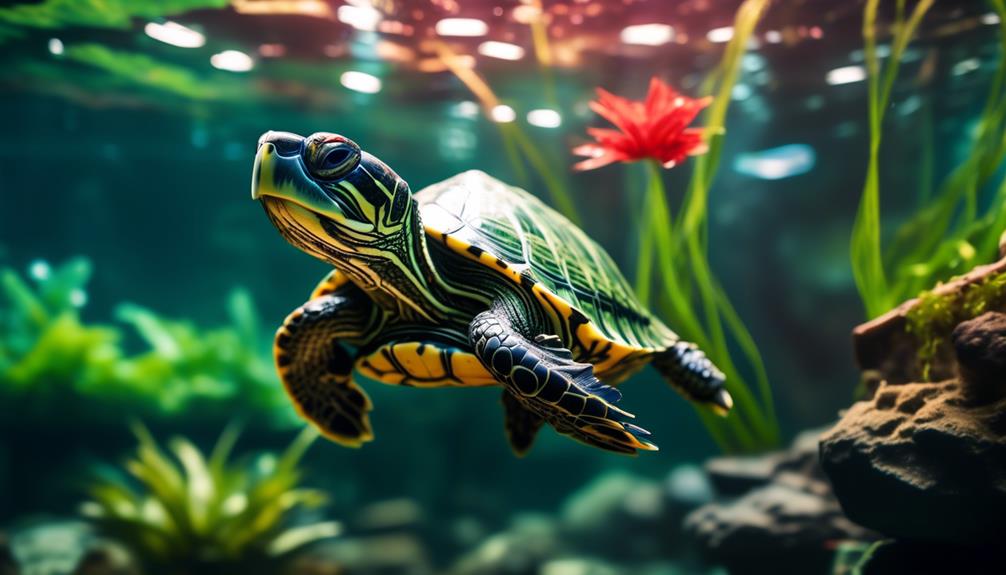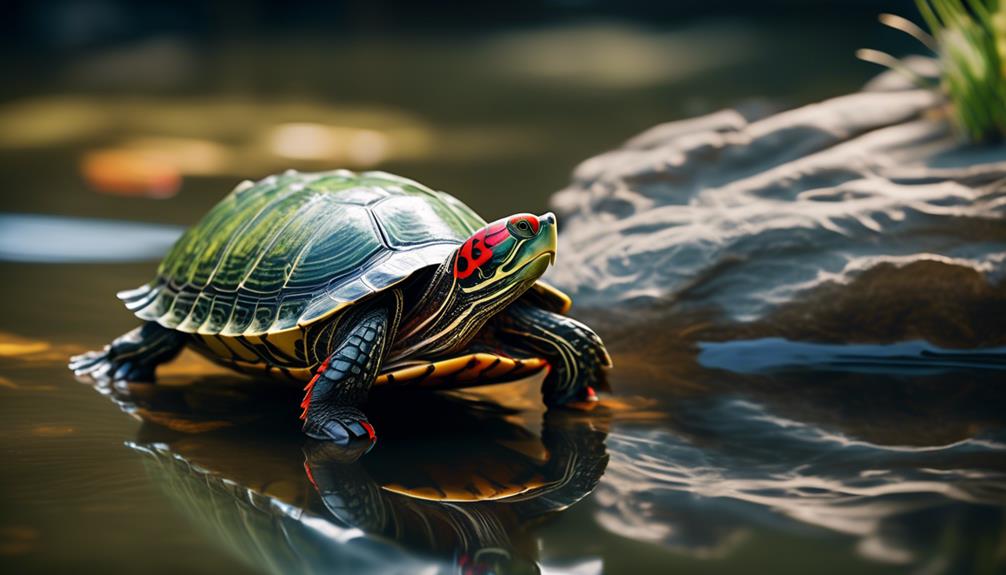
Are you aware that Red-Eared Slider Turtles can live up to 20 years or more in captivity?
This intriguing statistic is just the beginning of the captivating world that awaits you.
From their distinctive red stripe and sliding motion to their diverse diet and exceptional swimming abilities, these turtles have a lot to offer.
So, if you’re ready to embark on a journey of discovery and learn all about the fascinating world of Red-Eared Slider Turtles, then join us as we uncover the secrets and wonders that lie within their enchanting realm.
Key Takeaways
- Red-Eared Slider Turtles are popular pet turtles known for their distinctive red stripe behind their eyes.
- They require a spacious habitat with both land and water areas, along with a basking area and clean, filtered water.
- Their diet should consist of a balance of plants and protein, including commercial turtle pellets, leafy greens, and small aquatic animals.
- Red-Eared Slider Turtles prefer minimal handling and interaction with humans, and their health and care require regular veterinary check-ups, proper water quality and temperature, and UVB lighting for vitamin D3 synthesis.
General Information and Characteristics
Red-Eared Slider Turtles possess a captivating combination of traits and behaviors that make them truly fascinating creatures. These turtles are known for their vibrant red stripe behind their eyes, which adds to their charm. They’re great swimmers and spend most of their time underwater, but they also enjoy basking in the sunshine.
Native to the southern United States and northern Mexico, these turtles can live up to 20 years or more in captivity. Red-Eared Slider Turtles have an omnivorous diet, feeding on both plants and small aquatic animals. Their sliding motion and red mark on their head give them their unique name.
With their striking appearance and interesting habits, Red-Eared Slider Turtles are a captivating species to observe and appreciate.
Habitat Requirements

To ensure the well-being of these captivating creatures, it’s important to provide Red-Eared Slider Turtles with a suitable habitat that meets their specific needs. Here are three key requirements for creating the perfect habitat for your Red-Eared Slider Turtles:
- Spacious Environment: Red-Eared Slider Turtles need a tank or pond that allows them to move and grow comfortably. A cramped space can lead to stress and health issues.
- Temperature Regulation: Maintaining a water temperature between 75-85 degrees Fahrenheit is crucial for these turtles. A basking area with a heat lamp is necessary for them to regulate their body temperature effectively.
- Land and Water Areas: Red-Eared Slider Turtles require both land and water areas in their habitat. They need a place to swim and explore underwater, as well as an area to bask and dry off in the sun.
Feeding and Nutrition

To ensure the health and well-being of your Red-Eared Slider Turtles, providing them with proper feeding and nutrition is essential. These turtles have a varied diet consisting of both plants and protein.
You can feed them commercial turtle pellets, which provide essential nutrients. Leafy greens, such as lettuce and kale, are also important for their diet. Additionally, they enjoy eating small fish, insects, and worms.
It’s crucial to provide a balanced diet to ensure their health and well-being. Remember to monitor their feeding habits and adjust their diet accordingly.
Handling and Interaction

When interacting with Red-Eared Slider Turtles, it’s important to handle them gently and with care to avoid causing stress or injury. These turtles aren’t typically fond of being handled or petted, preferring to observe humans from a distance. To ensure their well-being, it’s best to keep interactions with them to a minimum, allowing them to spend their time swimming and basking in their habitat.
Health and Care

Regular veterinary check-ups are crucial for ensuring the health of your Red-Eared Slider Turtles. These check-ups allow the vet to monitor the overall well-being of your turtles and catch any potential health issues early on. Red-Eared Slider Turtles are prone to respiratory infections, shell rot, and vitamin deficiencies, so it’s important to keep a close eye on their health.
In addition to regular check-ups, maintaining proper water quality and temperature is essential for their well-being. These turtles require UVB lighting to aid in the synthesis of vitamin D3, which is crucial for their bone health. Providing a suitable environment with proper nutrition and care is key to ensuring the longevity and health of your Red-Eared Slider Turtles.
Popular Pet Turtle

Keeping a Red-Eared Slider Turtle as a pet offers a fascinating insight into the world of these captivating reptiles. They’ve become a popular choice for turtle enthusiasts for several reasons:
- Endearing Personalities: Red-Eared Slider Turtles exhibit unique behaviors and personalities that make them a delight to observe. From their curious nature to their adorable swimming and basking habits, they’re sure to bring joy to your life.
- Long Lifespan: These turtles can live up to 20 years or more in captivity, providing you with many years of companionship and enjoyment.
- Low Maintenance: Red-Eared Slider Turtles are relatively low-maintenance pets. With proper habitat setup and a well-balanced diet, they can thrive and bring happiness to your home without requiring excessive time and effort.
Native to Southern US and Northern Mexico

Red-Eared Slider Turtles are native to the southern United States and northern Mexico, making them a fascinating reptile species of the region. These turtles have adapted to the warm climate and can be found in various aquatic habitats such as lakes, ponds, and slow-moving rivers.
Their ability to thrive in these environments is due to their exceptional swimming skills and their preference for sunny areas where they can bask and regulate their body temperature.
Red-Eared Slider Turtles have become popular pets worldwide, but it’s essential to remember that they’re originally from the southern US and northern Mexico. Understanding their natural habitat and providing suitable care is crucial for their health and well-being.
Lifespan in Captivity

In captivity, Red-Eared Slider Turtles can live for up to 20 years or more, making them a long-lasting and rewarding pet choice. Here are three reasons why their lifespan in captivity is truly remarkable:
- Companionship: These turtles can become lifelong companions, providing you with years of friendship and joy. Imagine having a loyal and fascinating pet by your side for two decades or more.
- Witnessing Growth: Owning a Red-Eared Slider Turtle allows you to witness their growth and development firsthand. From a tiny hatchling to a magnificent adult, you’ll have the opportunity to observe their transformation throughout the years.
- Bonding Opportunities: As you care for your Red-Eared Slider Turtle over the course of its long lifespan, you’ll have ample opportunities to build a deep bond with your pet. The trust and connection that can be established over many years is truly special.
With their impressive longevity, Red-Eared Slider Turtles offer a unique and fulfilling pet ownership experience.
Distinctive Red Stripe and Sliding Motion

As you continue to explore the fascinating world of Red-Eared Slider Turtles, one cannot help but be captivated by their distinctive red stripe behind their eyes and their graceful sliding motion. This red stripe, also known as the “red ear,” is what gives these turtles their name. It starts behind their eyes and extends down the sides of their necks, adding a vibrant splash of color to their appearance.
But it’s not just their red stripe that makes them unique. Red-Eared Slider Turtles are known for their sliding motion, which is both graceful and efficient. They use their powerful hind legs to push off the ground and propel themselves forward, smoothly gliding through the water. This sliding motion allows them to navigate their aquatic habitat with ease, making them excellent swimmers.
To further illustrate the distinctiveness of Red-Eared Slider Turtles, here is a table highlighting their red stripe and sliding motion:
| Feature | Description |
|---|---|
| Distinctive Red Stripe | Vibrant red mark behind eyes and down the sides of their necks |
| Sliding Motion | Graceful and efficient sliding motion using powerful hind legs |
| Aquatic Navigation | Ability to smoothly glide through water, making them excellent swimmers |
These unique characteristics of Red-Eared Slider Turtles not only make them visually appealing but also contribute to their survival in their natural habitat. So next time you observe a Red-Eared Slider Turtle, take a moment to appreciate its distinctive red stripe and graceful sliding motion.
Frequently Asked Questions
Are Red-Eared Slider Turtles Good Pets for Beginners?
Red-Eared Slider Turtles can make good pets for beginners. They are popular and have unique characteristics. However, they require proper care, a spacious habitat, and a balanced diet to ensure their health and well-being.
Can Red-Eared Slider Turtles Live in Outdoor Ponds?
Yes, red-eared slider turtles can live in outdoor ponds. They require a spacious area with clean, filtered water and a basking spot. Make sure the water temperature is appropriate, and provide a balanced diet for their health.
How Often Should I Feed My Red-Eared Slider Turtle?
You should feed your red-eared slider turtle every day when they are young and gradually reduce to 2-3 times a week as they grow older. Offer a variety of foods to ensure a balanced diet.
Do Red-Eared Slider Turtles Require Any Special Supplements?
No, red-eared slider turtles do not require any special supplements. However, it is important to provide them with a balanced diet that includes commercial turtle pellets, leafy greens, and protein sources to ensure their health and well-being.
Can Red-Eared Slider Turtles Live With Other Turtle Species?
Yes, red-eared slider turtles can live with other turtle species, but it is important to research and understand the compatibility between different species before introducing them.
What are the similarities and differences between Red-Eared Slider Turtles and Yellow-Bellied Slider Turtles?
Red-Eared Slider Turtles and Yellow-Bellied Slider Turtles are both popular as pets. They share the same habitat, diet, and general care needs. However, the fascinating Yellow-Bellied Slider Turtle has a distinctive yellow pattern on its plastron, while the Red-Eared Slider has a red patch behind its eyes.
Conclusion
So there you have it, a glimpse into the captivating world of Red-Eared Slider Turtles.
These remarkable creatures offer a unique and fascinating experience as pets, with their vibrant red stripe and sliding motion.
From understanding their habitat requirements to providing a balanced diet, and from handling and interacting with them to ensuring their health and well-being, caring for Red-Eared Slider Turtles can be a rewarding journey.
So dive in and embark on this enchanting adventure with these captivating creatures.




